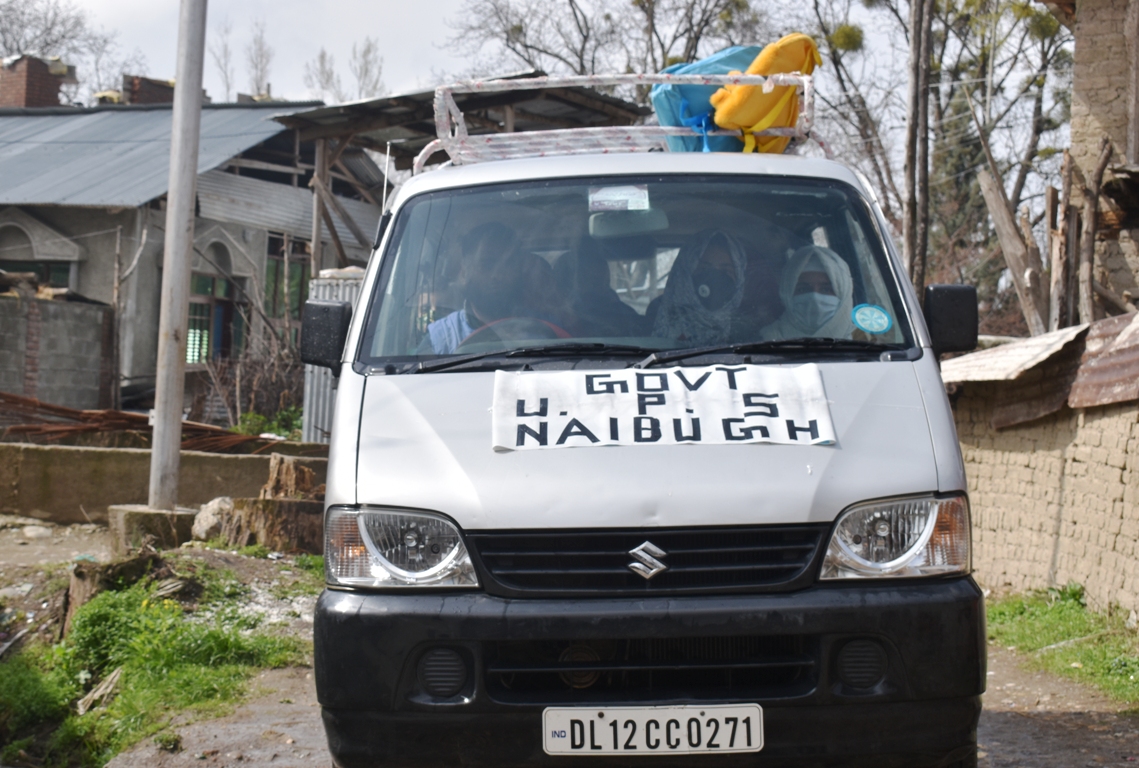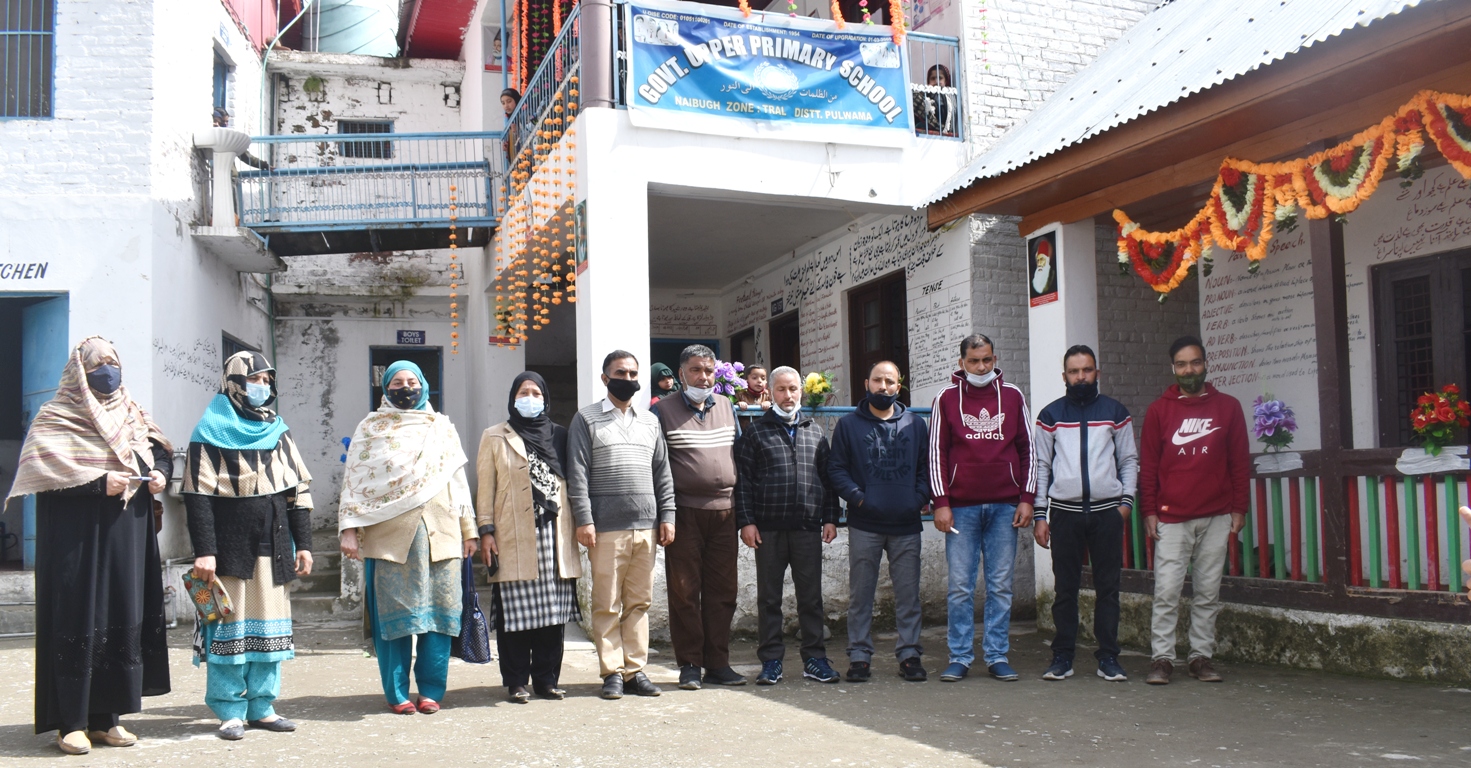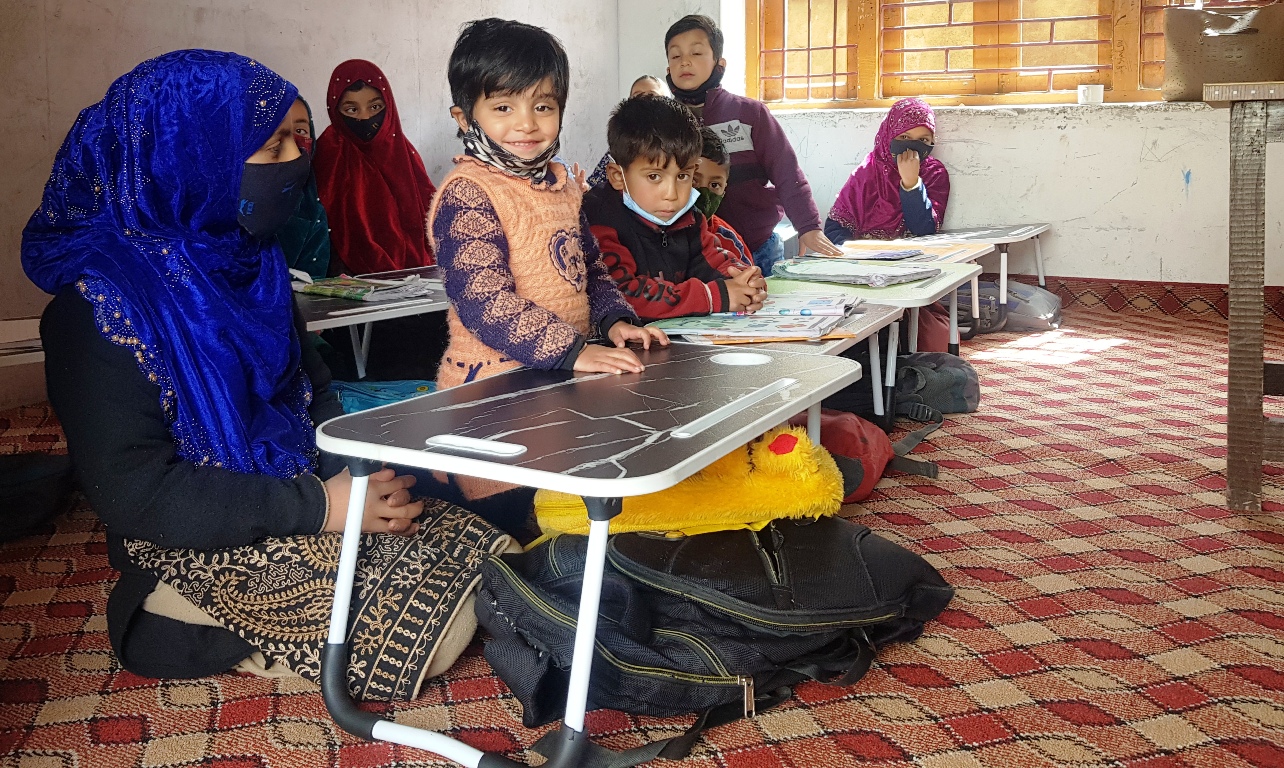Curriculum, poor infrastructure and unimpressive service in public schools are pushing parents to enrol their wards in the private sector schools. This is despite the fact that Jammu and Kashmir invests more than Rs 12000 crore in the education sector and has the best human resource. Now teachers of a south Kashmir government school are investing their blood and sweat to undo the trend by reimagining their school, Saifullah Bashir and Shakir Ashraf reports

With falling enrolment being a growing concern in the government-run schools along with lack of facilities driving away more students from the public sector schools, a Government Middle School (GMS) nestled in Tral’s Naibugh village has come up with an innovative and unique idea. The staff purchased a cab out of their own money to woo more students to the school.
The decision of teachers was prompted following this year’s decision by the Jammu and Kashmir School Education Department to conduct enrolment drives across to improve the enrolment.
“Many people accepted our invitation but everyone was demanding transport facility as they couldn’t send their wards to our school,” said Muzaffar Ahmed, a teacher at GMS Naibugh Tral.
Keeping in view the public demand, teachers of GMS Naibugh held a meeting under Headmaster Sunil Kumar Koul. They finally came up with a plan where they unanimously agreed to contribute to buy a cab out of their own pockets.
Koul, a resident from neighbouring Dadsara, led the move by donating one lakh rupees from his own pocket.
“When a government employee’s child can get good facilities, why cannot a poor man’s child at least get a van?” Koul said, adding that more such initiatives can be taken to attract students to the public sector.
Following Koul’s path, other teachers of the school came forward to donate resulting in a collection of additional Rs 1.50 lakh for buying a cab. In a couple of days, the school was able to generate a total of Rs 2.7 lakh among themselves.
“It was a blessing from God. We just started the initiative not knowing whether we would achieve our goal or not. But we have been able to start a good fight,” Koul said.
To keep the service running, the teachers are contributing Rs 1000 on monthly basis for fuel costs, driver’s salary, and other expenses.
“We have opened an account under the name of Teachers Welfare Fund. The money is automatically debited from our bank accounts,” Muzaffar said.

A Good Response
The innovative initiative is drawing more attention from parents in the area with some of them terming it a “noble initiative”.
“Within days we received 39 new admissions. We are hopeful it will increase in the coming days,” Ahmed added. The initiative has led the residents to talk about something that teachers never considered – ‘if teachers can contribute from their own salaries, they are serious people and would teach their wards better’.
Residents said the initiative has been a welcome change for the government schools in the area which otherwise are in the news for negative things only.
On daily basis, the school cab covers 50 km to and fro, attracting other students to the school.
“Roads in our village are in dilapidated conditions and during bad weather, it becomes difficult to walk. So, this step would definitely bring ease to us,” said Fatima, an eighth standard of the school.
Enrollment Crisis
The number of students has been a crisis in most of the public sector schools as the parents believe their wards are getting a better education in the private sector. In 2016, the Government Middle School Naibugh was established by clubbing Government Upper Primary School Naibugh and Primary School Naibugh which had 12 and 17 students, respectively at the time.

The 2016 government decision to club the two schools was implemented in letter and spirit.
“We had a total of 50 students in the two schools,” Ahmed said. However, the number has gone up from 59 to 96 after the school staff bought the van.
To ensure physical distancing in view of Covidd-19, the school cab does multiple rounds to ferry the students from four neighbouring feeding areas of Sherabad, Nowdal Bala, Sheikh Mohalla and Gulab Bagh.
The teachers not only contributed to the wealth but their time as well.
“We come one hour early and leave one hour late than our usual timing because we have to ensure that the students who come in batches are received by us. In the evening we follow the same schedule,” Ahmed said.
During last year’s Covid-19 induced lockdown, the teachers of the school were conducting classes in the open air for the students near the village stream.
Nothing New
The GMS Naibugh’s rendezvous with such unique feats by its teachers dates back to 2006 when it operated from two rooms. The then staff had bought land for upgrading the school infrastructure by contributing Rs 50000 out of their own pocket.
“The then headmaster Ghulam Rasool Rather contributed for the land and finally, 10 marlas were purchased for school building on which the majority of school buildings are currently built,” Ahmed said.
Apart from buying the cab and land, the school staff is also providing new desks, copies, pencil, and study material to the new students along with having special emphasis on “below average” students.
The staff believes that such initiatives if taken by the government are bound to bring back the public sector schools out of the morass they are caught up in.
They said that with the enormous funding available in the government sector schools in comparison to the private players, the government has the luxury of experimenting on new ideas like the ones they have employed in their school.
“It is the minds that need to be synced for such things to materialize,” Koul said. “If the government decides to adopt these things in just model schools of each district, it can turn out to be a game-changer for the government sector,” This, he adds, can overhaul the perceived image of the ‘Government school’.
“We want this initiative to be an ignition for the sector so that government gets into things, which were never thought of before,” the teachers insist.
“Teachers play an important role in a child’s life, and the parents are crucial in shaping the lives of children. The government must make teachers part of the change,” Koul said.
No Fee
In the last three years, the GMS Naibugh hasn’t charged any fee from its students in order to counter the school dropping out a practice that over the years has marred the government-run schools in Jammu and Kashmir.
“We didn’t charge any fee from students for the last three years. This year, we had to charge fees from some students as we couldn’t cater to everyone following the expenses on account of the cab,” Koul said.

The school is well maintained and provides all the basic necessities to the student but as the roll has increased the teachers said that authorities must come forward so that the school can further be enhanced.
“Our Zonal Education Officer has been helpful but then assistance can only come from the top level,” the staff members said.
Poor Infrastructure
The education department is the most populous department in Jammu and Kashmir. Jammu and Kashmir government is planning to spend Rs 11016.32 crore in the lower education sector and Rs 1365.24 crore in Higher Education during 2021-22.
The public education sector is manned by the most competent and well-paid staff. However, its outcome is hugely questionable and part of the blame goes to the poor infrastructure and syllabus.
The poor infrastructure along with poor learning, levels have been denting the public sector schools in Jammu and Kashmir leading to falling enrolment for which the department had started drives earlier this year.
A 2020-survey by the Ministry of Human Resource and Development had found that 80 per cent of government schools of Kashmir lack basic facilities of electricity, drinking water, and even toilets while many schools are without playgrounds and those having had either a playground outside their premises or is not accessible at all.
The survey revealed that of 23,747 government schools— 12,252 in Kashmir and 11,495 in Jammu, around 6,351 government schools were without toilets for girls and 8,098 schools have no toilets for boys. Only 5,000 government schools have electricity while more than 17,000 government schools are without electricity.
Niti Ayog in its 2020 report had observed, “Jammu and Kashmir has remained educationally backward compelling the state government to promote education in the state.” TheNiti Ayog had stated that there is a need to rationalize the scheme of providing free education at all levels in the state and to reconsider the decision of providing free education at the university level.
“The need of the hour is to learn the latest technologies available and government institutes need to be equipped with the latest infrastructure so that students are better informed,” the Niti Ayog had pointed out. The report further pointed out that the existing infrastructure is not sufficient, adequate infrastructure, training and learning material should be made available.
“Locally employed teachers should be encouraged to minimize absenteeism in schools, especially in remote areas. As in the case of Madhya Pradesh, village panchayats have been associated with the supervision of the functioning of schools in the villages. This experiment has met with considerable success in reducing absenteeism on the part of teachers in Madhya Pradesh. The government of Jammu and Kashmir could try this experiment too,” the Niti Ayog report reads further.
Vibrant Private Sector
In contrast, Kashmir private schools have modern infrastructure, quality education and adequate transport facilities. This is despite they operated merely on almost thirty per cent of the funds that the government invests in the sector.

Tahir Rasool, a student of one of the government schools said: “The private schools in Kashmir are provided with modern and well the developed infrastructure where students enjoy their studies, but here in our schools we don’t have even classrooms, we use to study under sunlight and face a lot of problems, we do not have any place for sanitation nor a playground, we want our schools developed like other Government schools outside the valley.”
A number of schools in the Kashmir periphery operate from the tiny rooms built over cowsheds or in certain cases in failed shops. While the Education Department is strictly ensuring all the facilities in private schools – including fire safety systems, it avoids looking inwards. That is the key factor why almost the two-thirds population of the teachers serving the Government-run schools have enrolled their wards in private schools.
Deflating Enrolment
Even as the government claimed a surge in enrolment for the current academic session, the figures reveal a dismal picture because the public sector schools managed to get only 31000 new students in comparison to losing 1.75 lakh students in the previous academic year.
The official figures reveal that Jammu and Kashmir has the worst retention rates in India with students continuously moving towards the private sector. The numbers of students moving out of the public sector are less than the number of out of school students suggesting that these students are in schools that aren’t government-owned.
As per official figures, the retention rate in government schools in the previous academic year was 60 per cent at the elementary level and only 50 per cent at the secondary level.
In November 2020, the Project Approval Board (PAB) – a unit of the Ministry of Human Resource Development – revealed in a survey that the enrolment at the elementary level in government-run schools in Jammu and Kashmir has decreased by 1.75 lakh in a year.
According to official numbers, the retention rate is very low in the Baramulla district at 41.52 per cent at the primary level and 46.68 per cent at the elementary level. However, the education department in its massive enrolment drive has claimed that this year the highest admissions in government schools were witnessed in the Baramulla.
Similarly in 2017-18 and 2018-19, there was a decline in enrolment of 3.8 per cent among all male students up to 10th standard in government-run schools.
In the academic year 2017-2018, a total of 57.3 per cent male students were enrolled in government schools of Jammu and Kashmir up to ninth class and above while in 2018-2019 only 53.5 per cent male students were enrolled.
In the case of female students, a total of 64.7 per cent of female students were enrolled in government schools up to ninth class and above in 2017-18 while in 2018-19 only 61.3 per cent of female students were enrolled.
Official figures further reveal that in 2015-16, the net enrolment rate in Jammu and Kashmir’s government sector was 55.7 per cent which in 2016-17, decreased to 47.1 per cent. Earlier in 2014-15, the enrollment of students in government schools in Jammu and Kashmir went down by 3.6 per cent in comparison to 2013-14.
As many as 18.16 lakh students were enrolled in government schools in 2014-15 compared to 18.84 lakh a year before.
According to MHRD’s data, government schools in Jammu and Kashmir have seen a sharp decline in student enrolment from 2012 onwards. The number went down to 16 lakh in 2016-17 from 19 lakh in 2011-12.
Private Sector Ahead
Around the same period when government schools lost three lakh students, the government set up 1497 new schools from 2011-12 to 2015-16.
As per MHRD figures, 72.5 per cent of students in urban areas of Jammu and Kashmir in the age group of 4-10 were enrolled in private unaided schools in 2018-19. Similarly, 60.1 per cent of students of urban areas in the age group of 11-14 years are also enrolled in private schools in Jammu and Kashmir indicating that more than half of the students in urban areas choose private schools over government schools.
In the age group of 15-18 years, 37.8 per cent of students of urban areas were enrolled in private schools in 2018-19 which however doest translate into adding of students in government schools in this age group. The decrease in the number of students from 60.7 per cent in the age group of 11-14 years to 37.8 per cent in the age group of 15-18 is mainly attributed to students dropping out of schools altogether due to varied reasons.
In rural areas, however, the MHRD figures present a different picture with government schools being preferred at the age group of 4-10 years. The figures reveal that only 36.7 per cent of students in this age group in rural areas of Jammu and Kashmir were enrolled in private schools in 2018. In the age group of 11-14 years in rural areas, only 29 per cent of students were enrolled in private schools. Similarly, in the age group of 15-18 years, only 15.6 per cent of students were enrolled in private schools in rural areas of Jammu and Kashmir.
The MHRD figures are similar to private school enrolment in Jammu and Kashmir in the subsequent year of 2019 and the preceding year of 2017 as well.
In comparison to this, the enrolment in private schools has been going up despite twin lockdowns in the Valley post-August 5, 2019.
For the current academic session (2020-2021), the private schools witnessed 70000 news admissions in just 1500 odd schools registered with the Private School Association of Kashmir.
In 2019, when Kashmir valley witnessed unprecedented lockdown post-August 5, the private schools witnessed 63000 new admissions in these 1500 schools in the month of October when the restrictions were still in place.















